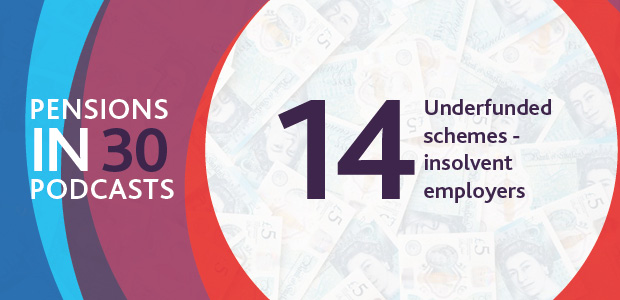If an employer is affected by an insolvency event the insolvency practitioner or official receiver is obliged to notify the trustees of the employer's pension scheme, the Pensions Regulator, and the Pension Protection Fund of the fact of the insolvency event. Here, we provide an overview of the pensions issues arising from employer insolvency.
 Subscribe
Subscribe
Download the fact sheet here.
Key points
- Independent trustee of pension scheme may be appointed
- Other trustees' discretionary powers fall away
- Employer as sole trustee ceases to act
- Employer debt: Section 75 Pensions Act 1995 and Occupational Pension Scheme (Employer Debt) Regulations 2005 may apply
- Scheme may qualify for entry to Pension Protection Fund under Pensions Act 2004 Section 126 onwards
- Trustees will be unsecured creditors in employer's winding up unless they have previously obtained security (such as a charge over assets)
Main sources
- Insolvency Act 1986 ss. 388 and 399 - appointment of insolvency practitioner
- Pensions Act 1995 ss. 22-26 - appointment of independent trustee and notifications to be given by the independent trustee; see also Pension Schemes Act 2015 s 44 (3)
- Pensions Act 1995 s 75 - debt on employer (deficiency of scheme assets); see also Occupational Pension Scheme (Employer Debt) Regulations 2005 (2005/678)
- Pensions Act 2004 ss. 126-181 - Pension Protection Fund
Appointment of independent trustee of pension scheme
If an employer is affected by an insolvency event the insolvency practitioner or official receiver is obliged to notify the trustees of the employer's pension scheme, the Pensions Regulator, and the Pension Protection Fund of the fact of the insolvency event.
The Pensions Regulator then has the power to appoint an independent trustee of the employer's pension scheme.
If appointed, the independent trustee is the only person who may exercise discretionary powers of the trustees under the pension scheme, and any powers held by the employer as trustee of the power. This would include any power the employer held to appoint or remove trustees of the pension scheme, for example.
In cases where the employer itself was the sole trustee prior to the insolvency event, it ceases to be trustee when an independent trustee is appointed. Other trustees do not automatically cease to be trustees, although they cannot exercise their discretionary powers while the independent trustee's appointment continues.
Debt on employer equal to deficiency in scheme assets
If an insolvency event occurs in relation to an employer before the employer's pension scheme starts to be wound up, the employer will be liable to pay to the scheme trustees the "section 75 debt on the employer". This "debt" is the difference between the amount of the scheme assets and the amount needed to secure members' benefits by purchasing annuity contracts.
This debt also becomes due from an employer at the start of a winding up of the pension scheme, independently of any insolvency event. In many cases the insolvency of the employer is a wind up trigger under the rules of the scheme in question.
If the insolvent employer is one of several employers participating in the pension scheme, it becomes liable for its share of the debt, based on its employees and their service periods, as set out in the Occupational Pension Scheme (Employer Debt) Regulations 2005.
Pension Protection Fund
The pension scheme of an insolvent employer may enter the Pension Protection Fund if it remains insufficiently funded after the trustees have collected any section 75 debt on the employer that they can recover.
If the scheme qualifies for admission, the Pension Protection Fund guarantees a specified level of pension benefits to the members of such a scheme. The Pension Protection Fund can also make "fraud compensation payments" where it believes that a scheme's assets have been reduced because of fraud after an insolvency event.
Pension scheme trustees and other creditors in insolvency
An insolvent employer will have other creditors, as well as the trustees of the pension scheme.
The trustees of the pension scheme have no automatic priority for their claim in the insolvency as against other creditors.
Like other creditors, the pension scheme trustees may have obtained priority for their claim prior to any insolvency by (for example) obtaining a charge over employer assets.
If that has not happened, the trustees will be unsecured creditors in the insolvency and will receive only such share of their claim as is available to all the employer's unsecured creditors.